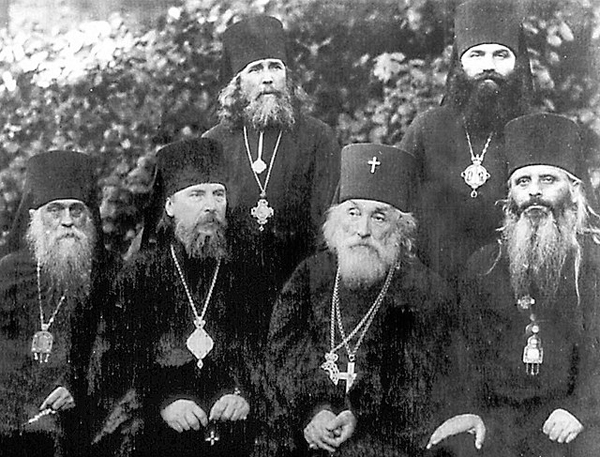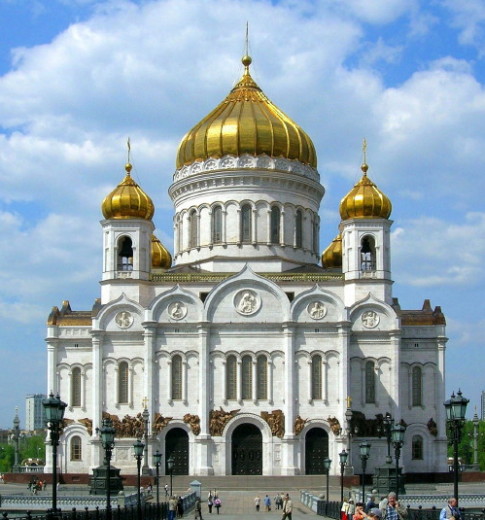Russian Orthodox church
Russian Orthodox church [Russian: Русская Православная Церковь; Russkaia Pravoslavnaia Tserkov (ROC)]. The largest contemporary autocephalous Orthodox church. It is headed by the ‘Patriarch of Moscow and All Rus’,’ who chairs the church's highest body, the Patriarchal Synod, which includes as permanent members the metropolitans of Kyiv, Saint Petersburg, and Krutitsy. In 1990 the Moscow Patriarch declared its Ukrainian and Belarusian exarchates the Ukrainian Orthodox church and the Belarusian Orthodox church. Although these new entities were granted considerable autonomy, they at present continue as components of the ROC. The synod has departments for administration, external church relations, publishing, economy, education, and other functions. The official organ of the church is the monthly Zhurnal Moskovskoi patriarkhii (32,000 copies in 1989). The patriarchate also publishes (since 1989) a weekly newspaper, Moskovskii tserkovnyi vestnik, and a monthly digest with the same name, in addition to various church and theological books and collections (eg, irregular collections put out by the theological academies, titled Bogoslovskie trudy) and separate journals for its exarchates abroad.
In the USSR in 1989 the ROC had 70 eparchies. Its hierarchy in 1986 comprised 82 individuals: the patriarch, 13 metropolitans, 41 archbishops, and 27 bishops (including 8 serving abroad and 6 retired hierarchs). In October 1989 there were approx 9,700 parishes, served by 8,100 priests and deacons, and 2,400 precentors. Although the number of the church's faithful is difficult to determine, it was estimated in the late 1970s at 30 to 40 million regular worshipers. In 1989 the ROC lost large numbers of believers and parishes in Ukraine to the Ukrainian Catholic Church, particularly in Galicia, and to the Ukrainian Autocephalous Orthodox church.
In November 1991 a sobor of the Ukrainian Orthodox Church issued a request to the patriarch of Moscow for the autocephaly of the Ukrainian church. The sobor of the ROC held in April 1992 refused that request and decided to replace Metropolitan Filaret Denysenko with Volodymyr Sabodan. In response to this, at an all-Ukrainian sobor in June 1992 one part of the Ukrainian Orthodox church, led by Filaret, decided to separate from the ROC and unite with the Ukrainian Autocephalous Orthodox church to form the Ukrainian Orthodox Church-Kyiv Patriarchate. The remaining part of the church remained subordinated to the Patriarch of Moscow and is known as the Ukrainian Orthodox Church-Moscow Patriarchate. Both churches exist separately and compete over parishes, church property, and the faithful in Ukraine.
From the late 1940s until the late 1980s the majority of operating Orthodox churches in the USSR (almost two-thirds) were located within the Ukrainian exarchate of the ROC, renamed the Ukrainian Orthodox church in 1990. In 1989 the ROC established an exarchate for Belarus, renamed the Belarusian Orthodox church in 1990. Outside the USSR the church has the Western European exarchate (based in London), the Central European exarchate (Berlin), the exarchate of Central and South America (Buenos Aires), an administration for its parishes in the United States (New York) and Canada (Edmonton), spiritual missions in the Holy Land, and a permanent representation at the World Council of Churches in Geneva. Other Russian Orthodox churches outside the USSR (which often number many Ukrainians among their members) retain ties with the ROC, for example, the Autocephalous Orthodox Church in America (formerly the Russian Orthodox Greek Catholic Church in North America). The Russian Orthodox Church outside Russia, however, stands in opposition to the ROC.
The ROC maintains two theological academies (in Saint Petersburg and Zagorsk, near Moscow) and six seminaries (Zagorsk, Saint Petersburg, Odesa, and, since 1989, Kyiv, Minsk [Zhirovitsky], and Tobolsk). In 1989 the academies graduated 37 full-time and 10 correspondence students; 192 full-time and 81 correspondence students completed study at the three seminaries (60 of them in Odesa). In 1988–9 the ROC was allowed to open five secondary theological schools—in Kishinev, Novosibirsk, Smolensk, Stavropol, and Chernihiv—primarily for the training of precentors. In addition the ROC operates one icon painting school and two women's choral conductor schools (in Moscow and Saint Petersberg). In October 1989 the ROC had 35 monasteries and convents (in 1980 there were only 16), including the Kyivan Cave Monastery, reopened in 1988.
According to the Soviet constitution, the church was separate from the state. In reality, however, the latter closely controlled the former, as it did all other religious groups, through the Council on Religious Affairs of the USSR Council of Ministers, analogous councils in the various republics, and plenipotentiaries in the individual oblasts. Prior to 1988 the activity of the ROC was limited to conducting services and performing other rites, and it was not permitted to engage in missionary, charitable, educational, or community political work (except in its officially sanctioned ‘patriotic’ activities). Though the ROC and other recognized religious groups acquired the rights of a juridical person, including property rights, the church did not have the right to own church buildings or their contents; they were loaned under contract by the state to a parish committee, usually composed of 20 lay people. These committees, which were officially registered with the state, were responsible for the parish's finances and activities, for hiring the priest, and so on. The state could refuse to recognize a parish, thereby making it illegal for the parishioners to gather or hold services. The state also gave permission for church synods and conferences, and for any other church function held outside the church premises. Until 1988, priests were not allowed to teach catechism to children, and organized religious instruction for people over 18 was strictly controlled. In 1988 a new all-Union law on the freedom of conscience and religious organizations was promulgated.
History. Officially the ROC traces its history to the introduction of Christianity in Rus’ (see Christianization of Ukraine) in the 10th century. In reality, however, the existence of the church dates only from the aftermath of the Mongol attack on Kyiv in 1240 and the transfer of the seat of the Kyiv metropoly to Vladimir on the Kliazma by Metropolitan Maximos after 1283. Subsequent metropolitans of Kyiv had their see in Moscow, which became the center of the new and rapidly growing Muscovite state (later Russia). With the increase in the strength and prestige of Moscow, the metropolitans began to demand their independence of the Patriarch of Constantinople, under whose jurisdiction the Kyiv metropoly remained.
In 1448 Grand Prince Vasilii of Moscow appointed Bishop Iona of Riazan the new metropolitan without the consent of Constantinople, and the ROC then declared its autocephaly, which was recognized by Constantinople only in 1589. Thus, beginning in 1458, two separate and distinct Eastern Slavic metropolies came to coexist: the Kyiv metropoly, or Ukraine-Belarus, and the ‘metropoly of Moscow and all Rus’.’
Having lost its links with the centers of Eastern Christianity, the Muscovite church increasingly became a tool in the state's hands. By the early 16th century, when Muscovy was freed from Mongol rule, the conviction gained currency that Moscow (‘the Third Rome’) was the direct descendant of Rome and Constantinople as a great Christian capital and center of Orthodoxy. This belief was buttressed after the fall of Constantinople in 1453 to the Ottoman Empire. The ROC consistently rejected closer relations with the Catholic West and opposed attempts at union (see the Church Union of Florence).
In 1589 the ROC became a patriarchate, but this did not diminish its subservience to the tsar. After the 10th patriarch (Adriian) died in 1700, no successor was appointed to his position for over 200 years. In 1721 the patriarch was officially replaced by the Holy Synod as the highest authority in the church. This completed the formal subjugation of the church, which became almost a governmental institution ruled by imperial fiat. The head of the Holy Synod was the ober-prokuror, a lay state official who was referred to as ‘the tsar's eyes.’ It was only in 1917 that the ROC was able to throw off briefly its state control. In November 1917 the All-Russian Local Sobor restored the patriarchate and elected Metropolitan Tikhon Beliavin as Patriarch of Moscow. After his death in 1925, the Soviet authorities prevented the election of a successor. From 1926 to 1943 the ROC was headed by patriarchal locum tenens Sergii Stragorodsky, who was elected patriarch in September 1943. After his death in 1944, he was succeeded by Patriarchs Aleksei Simansky (1945–70), Pimen Izvekov (1971–90), and Aleksei Ridiger.
In its expansion the ROC relied on the political strength of the Russian state, and spread its influence to the eparchies of Kyiv metropoly, especially after the Pereiaslav Treaty of 1654. The Kyivan metropolitans tried to resist this pressure and remain under the patriarchate of Constantinople, but they were unsuccessful; in 1686 the metropoly passed to the jurisdiction of Moscow. Many of the most learned clergy and hierarchy moved to Moscow and later Saint Petersburg, where they worked in church administration, education, missionary work, and so on. ROC missionaries established the church throughout the eastern Russian Empire, and Siberia, and even in Russian possessions in the Aleutians and Alaska, where an eparchy was established in 1870.
At its height the ROC owned vast estates and was extremely wealthy, and its affluence helped to attract many priests and monks. Increasingly, however, the state sought ways to limit its wealth, for example, by placing a ban on its acquisitions of new territories (1649). Tension between the two bodies reached its peak during the term of Patriarch Nikon (1652–8), who was removed from his position for defending too forcefully the church's prerogatives. Earlier his attempts to modernize the church had resulted in a major split, driving the Old Believers from the ROC. The persecution of the Old Believers in Muscovy forced many of them to flee, and some established colonies in Ukraine and Belarus.
The ROC furthered Russification among the peoples conquered by the Russians and in the various churches (eg, the Georgian Orthodox church) that came under Russian domination. In particular the Kyiv metropoly was prohibited from cultivating its traditional liturgical style and language (see Church rite) and forced to conform to Russian liturgical practices and rituals.
A major shortcoming of the ROC was the low level of education that marked the clergy in the 15th and 16th centuries. To combat this problem, the church brought in numerous foreign theologians and educators, such as Maximos the Greek (in the first half of the 16th century), who translated many Greek church books. In the 17th century numerous Ukrainian churchmen—Stefan Yavorsky, Dymytrii Tuptalo, Teofan Prokopovych, and others—also rose to prominence in the church hierarchy and in theological institutions. From the 19th century the situation improved markedly. By 1913 the ROC maintained 4 theological academies (in Kyiv [see Kyiv Theological Academy], Moscow, Saint Petersburg, and Kazan), 59 seminaries, and almost 200 other schools in the Russian Empire. (See also History of the Ukrainian church, Ukrainian Orthodox church, and Kyiv metropoly.)
BIBLIOGRAPHY
Ternovskii, S. Issledovanie o podchinenii Kievskoi mitropolii Moskovskomu patriarkhatu (Kyiv 1872)
Kharlampovich, K. Malorossiiskoe vliianie na velikorusskuiu tserkovnuiu zhizn’ (Kazan 1914)
Curtiss, J.S. Church and State in Russia: The Last Years of the Empire (New York 1940)
Mouravieff, A. A History of the Church in Russia (Oxford 1842)
Zernov, A. The Russians and Their Church (London 1945)
Kartashev, A. Ocherki po istorii Russkoi tserkvi, 2 vols (Paris 1959)
Hayward, B.; Fletcher, W. Religion and the Soviet State: A Dilemma of Power (New York 1969)
Pospielovsky, D. The Russian Church under the Soviet Regime, 1917–1982 (Crestwood, NJ 1984)
Ellis, J. The Russian Orthodox Church: A Contemporary History (London 1986)
Bohdan Bociurkiw, Ivan Korovytsky
[This article was updated in 1996.]

